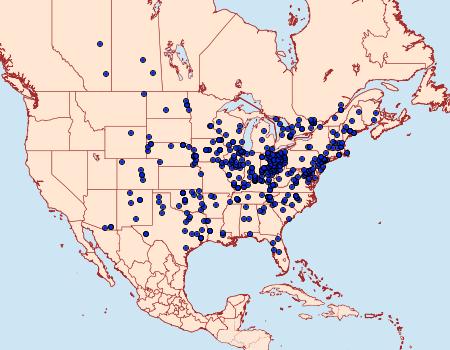Sphingidae
890102 –
7786 Ceratomia amyntor
(Geyer, [1835])
|
|
|
| Photographs are the copyrighted property of each photographer listed. Contact individual photographers for permission to use for any purpose. |

© Jim Farrell
|
| Distribution: |
Found in Canada from Nova Scotia west to Saskatchewan. In the US, it occurs from New England west to North Dakota, Nebraska and Eastern Colorado. It is less common in the south, but can be found from Florida to eastern Texas. |
Seasonality
and Size: |
One brood in the north from May-Oct, two broods in the south. Wingspan 88 - 115 mm. |
Larva and
Host Plants: |
Larva is brown or green, with spinulose horns on the thorax, in addition to the horn at the end of the abdomen, leading to its alternate common name of Four-horned Sphinx. Much of the body is covered with white granules and a ridge of scalelike plates runs down the dorsal midline. The food plants are elm, basswood, and birch. (see references) -- Host familiy: Betulaceae Fabaceae Fagaceae Malvaceae[Tiliaceae] Oleaceae Rosaceae Ulmaceae. Host genera: Betula Fagus Quercus Robinia Fraxinus Prunus Tilia Ulmus. Notes: leaves (Wagner 2005). (Shropshire & Douglas 2025)
|
Description/
Field Marks: |
• brown thorax with wide darker brown stripes towards the edges.
• forewing light brown with whitish pm. line, dark streaks along veins, white tint along the costa and whitish reniform spot.
• hindwing brown with a dark brown border and incomplete lines. |
| Similar Species: |
- 890106 Ceratomia hageni: forewing pattern overlaid with green, pale gray patches at tip of forewing and mid-costa. Found only in Kansas, Arkansas, Missouri, Mississippi and Texas.
- 890104 Ceratomia sonorensis: is found in southern Arizona, 3 black dashes on forewing.
- 890103 Ceratomia undulosa: reniform spot large, white with black outline.
- 890105 Ceratomia catalpae: yellowish brown with relatively indistinct lines on forewing. Reniform spot black with gray filling.
- Pinned specimens of related species. (Hint: select View by Region on the related species page.)
|
| Synonymy: |
amyntor (Geyer, [1835]) (Agrius) - MONA 1983: 7786quadricornis Harris, 1839 (Ceratomia)ulmi Boisduval, [1875] (Ceratomia) |
|
| References (Caution: DNA barcoding at BOLD provides evidence of relatedness, not proof of identification; some BOLD specimens shown may not be sequenced.) |
- Barcode of Life (BOLD) - Caution: Identifications often erroneous; DNA barcode provides evidence of relatedness, not proof of identification; many specimens not sequenced.
- Covell Field Guide p.33; Pl. 3(9, male).
- Hall et al., 2021. The Moths of North Carolina - website (identification, habitats and life history)
- Hodges, R. W., 1971. Moths of America North of Mexico, Fascicle 21:p. 41; pl. 2.6. order or free PDF
- Shropshire, K.J. & D.W. Tallamy, 2025. Lepidoptera of North America, north of Mexico: an annotated list containing geographic ranges and host-plant records. ZooKeys, 1261: 101-113; Suppl. 1. (PDF or read online)
- Species Page at Bill Oehlke's moth website - Ceratomia amyntor
- Species Page at Block Island Moths
- Species Page at BugGuide.Net
- Species Page at E. H. Strickland Museum
- Species Page at Mass Moths
- Species Page at Pacific Northwest Moths
- Species Page at iNaturalist
- Species page at Moths of North Dakota.
- Tuttle, J. P., 2007. Hawk Moths of North America: p. 63; pl. 9.8.
- Wagner, D. L., (2005). Caterpillars of Eastern North America, p. 250.
|
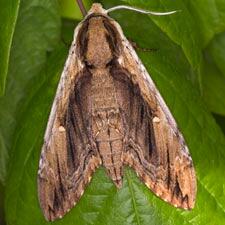
© Alan Chin-Lee

© D. Lynn Scott

© Patrick Coin

© Janice Stiefel - m.

© Nolie Schneider
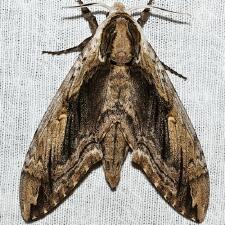
© Carol Wolf
|

100mm – © Jim Vargo
|
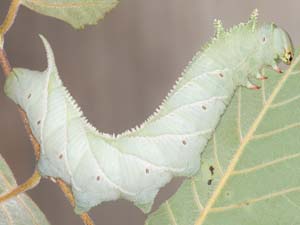
© George Smiley LG
on Betula nigra
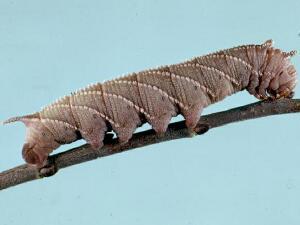
© Canadian National Collection LG

© Teá Montagna LG
5th Instar on Ulmus

© Teá Montagna LG
4th Instar on Ulmus

© Teá Montagna LG
3rd Instar on Ulmus
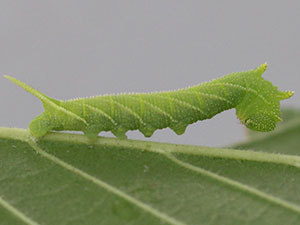
© Teá Montagna LG
2nd Instar on Ulmus
|











